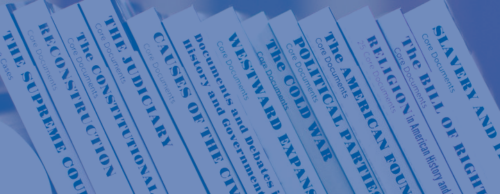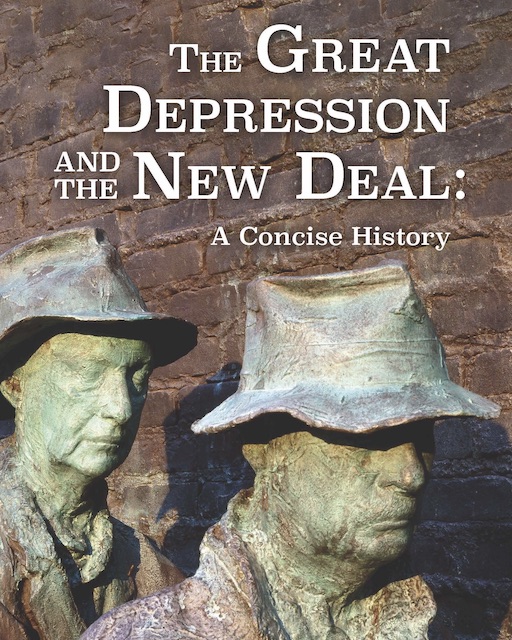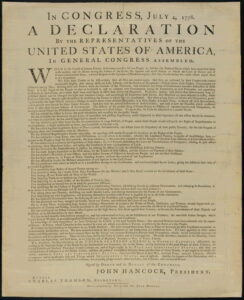
Teaching American History’s Narrative Histories
Teaching American History emphasizes the use of primary documents. Why, then, is Teaching American History publishing a series of narrative histories?
In case you didn’t know about the narrative histories, let me describe them, before I explain them. There will be six:
- Discovery and Settlement
- The Founding, 1789–1800
- Civil War, 1850–1876
- The Emergence of Modern America, 1880–1920
- The Great Depression and the New Deal, 1929–1939
- America in the Age of the Vietnam War, 1960–1980
Each volume covers a critical period in American history (are there any periods that weren’t?). The subtitle of each is “A Concise History,” because that is what each will be. John Moser’s history of the Great Depression and the New Deal, the only one published so far, is 145 pages. In that brief space, John narrates what happened in the ten years he covers. He tells the story of the economic crisis that followed the stock market crash of 1929, the efforts of Herbert Hoover and Franklin Roosevelt to address it, and the economic and political changes wrought in the United States by Roosevelt’s New Deal. In doing so, he reviews the various interpretations offered by the participants in the events he narrates and those who subsequently studied them. In all of this, his narrative is tied to and helps readers understand the 43 primary documents in The New Deal and the Great Depression: Core Documents that John also edited.

But why does TAH offer John’s narrative (and the others), if primary documents are so important?
The idea for the narrative histories came from the experience of teaching the MAHG course on the American Revolution. Several teachers who took the course mentioned that Gordon Wood’s short volume The American Revolution, which was part of the assigned reading, was helpful to them because they did not have an overview of the period and Wood’s book provided it. Talking to them it, we realized that by an “overview” they meant at least three things.
First, they meant a chronology of events, a clear statement of what happened before and after a specific primary document. The chronology helps in understanding the significance of the document, why it was written and what effects it may have helped produce. For example, John’s documentary history contains two documents on the relationship of African Americans to the New Deal. Both provide insight into specific aspects of black life during the depression. John’s narrative places what those documents tell us in the longer-term movement of black voters from the Republican party to the Democratic party. This movement has had a significant effect on American political life ever since. John’s narrative helps us understand why those two primary documents were written. It helps us look forward to the post World War II civil rights movement, even though Roosevelt himself was for political reasons guarded in his dealings with the issue of black civil rights.
Second, the author of a primary document is always aware of more about his current circumstances than a reader many years later will be. As the New Deal continued, for example, Roosevelt was quite aware of his critics, but he did not necessarily even mention them, let alone describe their criticisms accurately or fairly in detail in his speeches. John’s documentary history of the Depression and New Deal includes some of the critics, of course, but his narrative account gives all of them, including extremists of the left and right, due consideration. In doing so, he allows us to better judge FDR’s political maneuvering to deal with them. Ultimately, the context John provides allows us to weigh the argument that the New Deal saved democratic capitalism rather than undermined it.
Finally, as the second reason for the narrative histories suggests, the narrative and the documents work together and allow us to question each more thoroughly. Readers who work through the primary documents will be able to question John’s narrative, just as reading the narrative will allow them to return to the documents with the knowledge they need to better question and evaluate what each author says.
This process of reciprocal questioning is like what happens or should happen in the discussions we have in our MAHG classes and in our one day and multiday seminars.
As these reasons suggest, the narrative and the documentary histories are meant to work together to deepen our understanding of the period they treat. To that end, each narrative history includes a chronology and an appendix that lists by chapter the primary documents from the corresponding documentary history discussed in that chapter. Each of the narrative histories, with the exception of the Founding, will be written by the editor of the corresponding core document collection. The next two to appear (both in the 2024-25 academic year) are The Emergence of Modern America and America in the Age of the Vietnam War.



